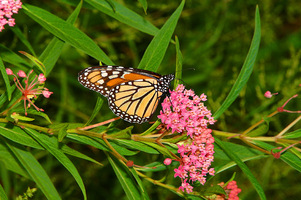
Butterflies, belonging to the second-largest insect order Lepidoptera, are brightly colored, diurnal insects with four scaled wings, two clubbed antennae, and three pairs of legs. Of the nearly 15,000 species of butterflies occurring worldwide, about 135 species are represented in West Virginia. Because of its physiography and geographic position in the eastern United States, West Virginia hosts a rich diversity of plant life including many southern and northern species that reach the limits of their range here. Since most butterflies prefer habitats that produce an abundance of their host plants, the diverse flora of West Virginia supports butterflies typical of both northern and southern regions. In addition to being restricted to the immediate area of their host plants, many butterflies are also limited to specific habitat types and microclimates.
Within the order Lepidoptera, butterflies are divided into two superfamilies: the true butterflies (Papilionoidea) and the skippers (Hesperioidea). The less brightly colored skippers are distinguished from the true butterflies by their smaller size, large heads, stout bodies, and rapid flight. Of the ten families of true butterflies, five occur in West Virginia. These include the swallowtails (Papilionidae); whites and sulphurs (Pieridae); harvester, coppers, hairstreaks, and blues (Lycaenidae); metalmarks (Riodinidae); and the brushfoots (Nymphalidae). Hesperidae, one of the two families of skippers, also occurs in the state. Each family is further divided into a number of subfamilies, genera, and species.
Butterflies go through four stages of development: egg, caterpillar, chrysalis, and adult. Most butterflies will reach the adult stage from the egg in about four weeks unless the process is broken by hibernation or diapause. Females deposit the small, hard-shelled eggs on or close to the host plant. Most caterpillars hatch within a few days, chewing their way out of the egg. Feeding on the leaves, buds, or fruit of their host plants, caterpillars molt periodically over a period of approximately four weeks until growth is completed. With the last molt the caterpillar is enclosed in a hard-shelled chrysalis. The chrysalis is a transition stage, with some species remaining enclosed for almost a year while others emerge as adults within several days. Depending upon the species, adult butterflies may live from only a few days to almost a year, feeding, seeking mates, and reproducing. The longer-lived butterflies usually hibernate or migrate. The well-known Monarch, West Virginia’s state butterfly, follows an annual migration route from the Mountain State to Central Mexico. Monarch numbers have dropped in recent years, mainly because landowners have cleared untold acres of milkweed, the only plants monarch caterpillars feed on. The Fish and Wildlife Service has been considering placing the monarch under Endangered Species Act protection since 2014. In 2022, the International Union for Conservation of Nature added the migratory monarch to its endangered list after its numbers shrunk because of rising temperatures, deforestation, and pesticide use.
Abundant almost everywhere, and feeding as a group on an enormous variety of plants, Lepidoptera can be of great ecological and economic importance. Their larvae transform millions of tons of plant matter into animal matter and wastes that can be eaten by other animals or eventually recycled back into plant nutrients. Unlike such other members of Lepidoptera as the gypsy moth, butterflies are usually small in number and do not impose serious impacts on the flora of the state. They serve an important role as food sources for other invertebrates, birds, and other animals, and flowervisiting adults are second only to bees in the cross-pollination of many flowering plants.
This Article was written by Thomas J. Allen
Last Revised on October 18, 2023
Related Articles
Sources
Allen, Thomas J. The Butterflies of West Virginia and their Caterpillars. Pittsburgh: University of Pittsburgh Press, 1997.
Cite This Article
Allen, Thomas J. "Butterflies." e-WV: The West Virginia Encyclopedia. 18 October 2023. Web. 26 July 2024.


Comments?
There aren't any comments for this article yet.
Click here to read and contribute to the discussion →